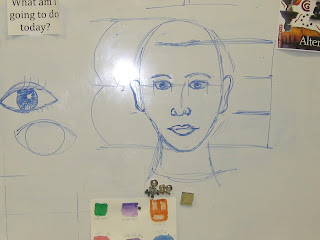How to Critique Art
Critical Method lesson: Art Criticism using The Critical Method
(Also known as the Feldman Method)
Choose a famous work of art and go through the steps
explained below.
Go through the steps of the critical method to
critique the work.
Art criticism is responding to,
interpreting meaning, and making critical judgments about specific works of
art.
The critical method is a process of 4 steps: Describe, Analyze, Interpret, Evaluate
Lesson Objective:
students will learn the vocabulary of art (the elements and principles of
design) and identify these elements and principles in a work of art. Students will objectively identify facts in
the description and analysis steps, and then use more subjective observations
in the interpretation and evaluation steps. Art appreciation:
Vocabulary: Elements of art: line, shape, form,
value, space, texture, color
Principles of art (made up of the elements): balance,
contrast, unity, variety, emphasis, pattern, movement, rhythm
Subjective and objective, aesthetics, medium,
appreciation, abstract art and representational art, composition
1.
Describe: Title, artist, medium, date
Ask students “What do you see in the artwork”? and
“What else”? Includes content and subject matter in representational works,
includes abstract elements in nonrepresentational pieces. When describing,
students will go through each element of
design and find examples in the artwork of those elements. Students should
be able to find at least three examples of each element and describe it in
detail. Students are to use facts only
(objective observations) when describing.
2.
Analyze:
Focus on the formal aspects of elements of art,
principles of design, and other formal considerations: exaggeration,
composition etc. “How does the artist create a center of interest?” How does
the use of color impact the painting? ” When analyzing, students will go
through each principle of design and find examples in the artwork of those
principles. Students should be able to find at least two to three examples of
each principle and describe it in detail.
Students are to use facts only (objective observations) when
analyzing.
3. Interpret: This step
allows for subjective observations (opinions). Propose ideas for possible meaning based on evidence. “What do you think it
means”? “What was the artist trying to communicate”? “What clues do you see
that support your ideas”? “What emotions
and feelings are expressed in the work?”
“Why did the artist create this work?”
Interpretations are heavily influenced/changed once
more is learned about the artist’s life, the time period, and sometimes even
explanations about the meaning by the artist himself/herself. Students can critique any artwork without any
prior knowledge or understanding of the art or artist. However, the more information
a student knows about the time period, historical events, etc., then the more
thorough and accurate the student’s critique will be.
4.
Evaluate
(judge): Discuss the overall strengths/success/merit of the
work. Students should consider the following when determining a judgement:
- Do
I like or dislike this work and why?
- Is
there evidence the artist is aware of the elements and principles of design?
- Is
this an important work of art?
- Is
the work of art influential, controversial, and/or have importance in society?
- Is
this artwork groundbreaking?
It is really important to
stress to students that they personally might not like the artwork, but they
can still have appreciation for it and think it is overall a success.

Comments
Post a Comment